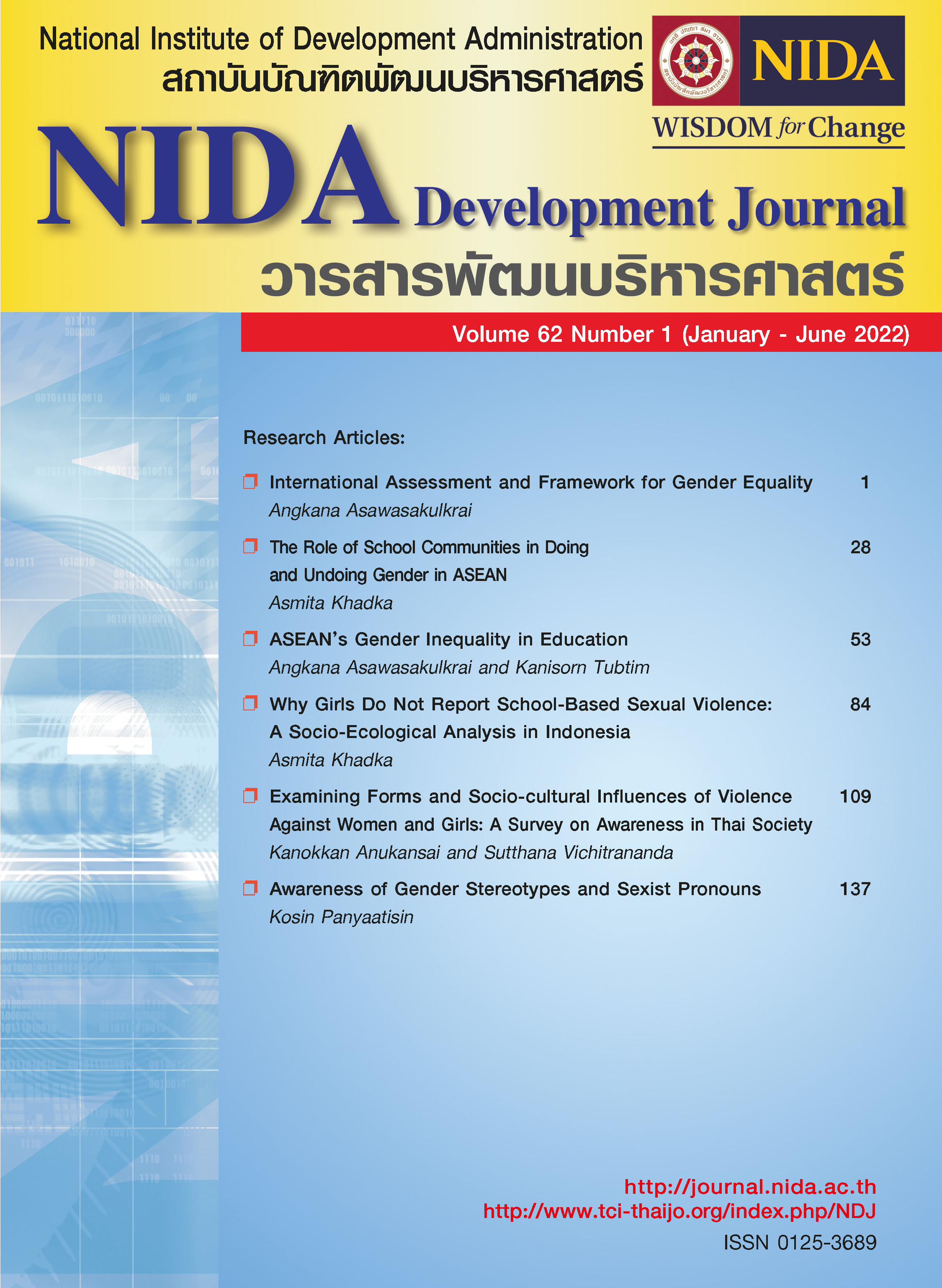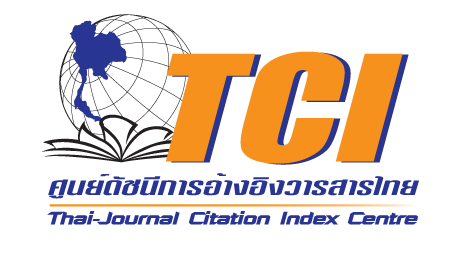ASEAN’s Gender Inequality in Education
Keywords:
Gender Inequality, ASEAN, Gender Hierarchy, Education, Sexual ViolenceAbstract
As education is one of the first basic human rights, this study examines the landscape of gender inequality specifically in the educational context within Southeast Asia. Schools have unparallel abilities to educate, cultivate, and instill the value system into children as they grow and learn to become productive members of society. The study explores the overall status of gender inequality in ASEAN and investigates both explicit and implicit gender-related issues found in primary, secondary, and tertiary educations. The study gathers primary data from the school visits in Thailand, gender expert interviews, and teachers’ surveys from ASEAN member countries, which were conducted by the Center for Philanthropy and Civil Society (CPCS), National Institute of Development Administration (NIDA). The results corroborate the gender situation in ASEAN in that gender inequality in education still exists in great lengths. Gender roles, norms, and stereotypes widely dictate people’s way of life and practices. Gender hierarchy where males are considered superior and the patriarchal structure remain in the front row seat in almost all areas of life. In consequence, the education system in Thailand and other Southeast Asian countries are in serious need of a radical change and reform. It would benefit from gender mainstreaming policy, including direct policy interventions in educational curricula, textbooks, school’s staff and faculty’s understanding and perceptions of gender issues, and other school practices. Meanwhile, the promotion of gender equality must also be a priority.
References
Alan, S., Ertac, S. & Mumcu, I. (2021). Gender Stereotypes in the Classroom and Effects on Achievement. MIT Press Journals
ASEAN Commission on the Promotion and Protection of the Rights of Women and Children. (2019). ACWA Progress Report on Women’s Human Rights & Gender Equality. Retrieved from https://asean.org/?static_post=progress-report-womens-rights-gender-equality
ASEAN Secretariat. (2019). ASEAN key figures- 2019. Retrieved from https://www.aseanstats.org/wp-content/uploads/2019/11/ASEAN_Key_Figures_2019.pdf
Barres, B. A. (2006). Does gender matter?. Nature, 442(7099), 133-136.
Center for Philanthropy and Civil Society, National Development Administration. (2021). Elimination of gender stereotypes and sexist language in educational materials in primary and secondary levels: phase 1 and 2. Retrieved from http://www.cpcs.nida.ac.th/home/index.php/component/sppagebuilder/page/21
Ena, O. T. (2013). Visual analysis of e-textbooks for senior high school in Indonesia (Doctoral dissertation, Loyola University Chicago).
International Labour Organization (ILO). (2017, December). The gender gap in employment. Retrieved from https://www.ilo.org/infostories/en-GB/Stories/Employment/barriers-women#intro
Jasmani, M. F. I. M., Yasin, M. S. M., Hamid, B. A., Keong, Y. C., Othman, Z., & Jaludin, A. (2011). Verbs and gender: The hidden agenda of a multicultural society. 3L: Language, Linguistics, Literature®, 17.
Jha, S. & Saxena, A. (2016). Projected Gender Impact of the ASEAN Economic Community. UN Women Asia and the Pacific.
Lee, J. F., & Collins, P. (2008). Gender voices in Hong Kong English textbooks—Some past and current practices. Sex Roles, 59(1-2), 127-137.
McKinsey Global Institute. (2018). The Power of Parity: How Advancing Women’s Equality Can Add $12 Trillion to Global Growth.
Pauwels, A., & Winter, J. (2004). Gender-inclusive language reform in educational writing in Singapore and the Philippines: A corpus-based study. Asian Englishes, 7(1), 4-20.
Setianto, N. (2020). Advancing Gender Equality in Southeast Asia: Case Studies from the Philippines and Singapore. Australian Institute of International Affairs. Retrieved from https://www.internationalaffairs.org.au/australianoutlook/advancing-gender-equality-in-southeast-asia-case-studies-from-the-philippines-and-singapore/
Study International. (2019). Schools may perpetuate gender inequality without realizing it. Retrieved from https://www.studyinternational.com/news/gender-inequality-school/
The ASEAN Post. (2018). Not Enough Women in Parliament. Retrieved from https://theaseanpost.com/article/not-enough-women-parliament
The ASEAN Post. (2018). The Cost of Gender Inequality. Retrieved from https://theaseanpost.com/article/cost-gender-inequality
The News Lens International Edition. Towards Solving ASEAN’s Gender Inequality Problems. Retrieved from https://international.thenewslens.com/article/81016
The OECD (2021). The Social Institutions and Gender Index in the Southeast Asian region. Retrieved from https://www.oecd-ilibrary.org/sites/b01a4f2f-en/index.html?itemId=/content/component/b01a4f2f-en
UN Office on Drugs and Crime. (2013). World Drug Report 2013. Retrieved from https://www.unodc.org/unodc/secured/wdr/wdr2013/World_Drug_Report_2013.pdf
UN Women, UNICEF (2020). A New Era for Girls: Taking stock of 25 years of progress. Retrieved from https://data.unicef.org/resources/a-new-era-for-girls-taking-stock-of-25-years-of-progress/
UN Women. (2021). Four facts you need to know about gender and poverty today. Retrieved from https://data.unwomen.org/features/four-facts-you-need-know-about-gender-and-poverty-today
UNDP. (2018). Human Development Data (1990-2018). Retrieved from http://hdr.undp.org/en/data#
UNDP. (2019). Human Development Report 2019. Retrieved from http://hdr.undp.org/sites/default/files/hdr2019.pdf
United Nations Girls’ Education Initiative, UNESCO. (2018). Global Education Monitoring Report Gender Review 2018: Meeting our commitments to gender equality in education. Retrieved from https://resourcecentre.savethechildren.net/library/global-education-monitoring-report-gender-review-2018-meeting-our-commitments-gender
United Nations. (2019). The Sustainable Development Goals Report 2019. Retrieved from https://unstats.un.org/sdgs/report/2019/The-Sustainable-Development-Goals-Report-2019.pdf
Vu, P. A. (2008). Gender stereotypes in story textbooks for primary school students in Vietnam. University of Oslo.
World Bank Group, Poverty and Equity Global Practice & Gender Global Theme (2018, March). Gender Differences in Poverty and Household Composition through the Life-cycle: A Global Perspective
World Bank. (2020). Government expenditure on education, total (% of GDP) – Philippines. Retrieved from https://data.worldbank.org/indicator/SE.XPD.TOTL.GD.ZS?locations=PH
Zafar, M. (2020). 16 Shocking facts about violence against women and girls. Islamic Relief. Retrieved from https://reliefweb.int/report/world/16-shocking-facts-about-violence-against-women-and-girls
Downloads
Published
How to Cite
Issue
Section
License
Copyright (c) 2023 NIDA Development Journal

This work is licensed under a Creative Commons Attribution-NonCommercial-NoDerivatives 4.0 International License.





